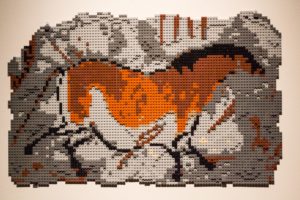There are, according to various sources, more than 440 billion pieces of Lego in existence, and it feels like most of them are now on display in a entertaining exhibition at the Canadian Museum of Science and Technology.
The Art of the Brick is a collection of sculptures by Nathan Sawaya that are made entirely of Lego, from the 760 pieces in a simple pair of flip flops to the 80,200 pieces in a Tyrannosaurus Rex. There are familiar animals (dog), routine poses (a human swimming), reproductions of the world’s best-known artworks (Mona Lisa) and many things large and small, realistic and surrealistic, that sprang wholly from the mind of Sawaya.
Sawaya was a corporate lawyer in New York City, until he decided that building cases was less rewarding than building most anything from the world’s most ubiquitous toy. And the ubiquity of Lego is not in doubt: National Geographic says that enough new pieces of Lego are produced every year to reach around the world more than five times. There are at least 62 pieces of Lego in existence for every person on Earth, which is why everyone knows what it’s like to step on a piece of the ‘Ow-you-kids-put-your-damn-toys-away’ blocks.

The Second Chinese Horse, which is a recreation of a 17,000 year old cave drawing in 1,700 blocks of Lego (give or take a few).
Lego is the simplest of toys, a building block held back only by the horizons of the builder’s imagination. Sawaya demonstrates how far back those horizons can be pushed — in one case literally. The exhibition starts with Sawaya’s versions of famous works of art, including Edward Munch’s painting The Scream, here rendered in three-dimensional depth, with the screaming human figure in front of a panel of plastic that swirls and burns with Munch’s famously unsettled horizon.
Nearby is Van Gogh’s Starry Night, Rodin’s The Thinker and even a 17,000-year-old cave painting, recreated in 1,700 blocks (give or take a few). There’s a portrait of Andy Warhol that surely would have pleased the master of consumer-product pop art (1,657 pieces). There’s a delightful version of Van Eyck’s Arnolfini Portrait, rendered in 1:1 scale (the original painting is tiny) in 7,023 pieces. With its fashionable couple separated from the opulent bedchamber that is the background, it is less portrait than installation, and it hints of much to come later in the exhibition.
There’s a telling installation in the next room titled The Artwork Inside, (3,840 pieces), of a life-sized man with his heart exposed. A wall panel quotes Sawaya, “When I began making art, I had a lot of art world traditionalists question my use of a popular toy as a medium.” I was thinking of that point a few moments later as I stood over his selection of Lego skulls. If Damien Hirst’s skulls are art, then why not Sawaya’s?

There are 80,200 pieces in this Tyrannosaurus Rex.
Where Sawaya succeeds most impressively is in collaboration with the photographer Dean West. This is Lego seen anew. Sawaya built his creations of blocks and with West inserted them into digital scenes, sometimes prominently and sometimes inconspicuously. In one photograph a man stands on a pool deck and you’d wonder where the Lego is, except beside it are the plastic-block flip flops and towel that are seen in the image.
The blockbuster — you knew you wouldn’t get through this without that obvious pun — is a photograph of a woman in a red dress in front of a noir-ish theatre. She stands still, arms clenched in front of herself, cold, perhaps frightened, her dress billowing behind her and seemingly coming apart, as if pixel by pixel. Next to the photo is the dress, suspended from the ceiling, and the pixels are revealed as individual blocks of Lego.
It’s a long way from the boxy “castles” I used to make from Lego, further, much further, than I ever dreamed that Lego could go.
The Art of the Brick continues to Sept. 3.






